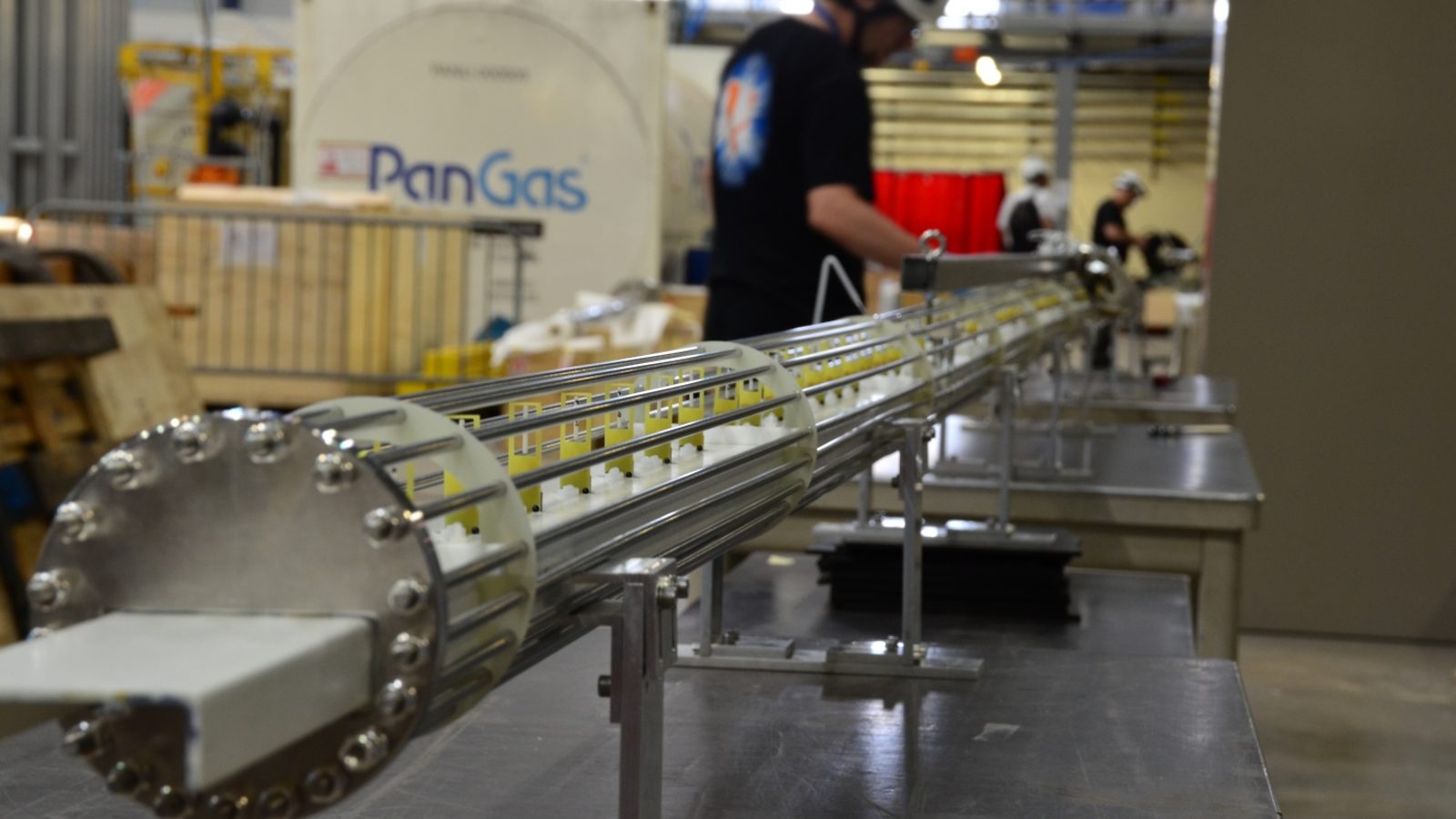When crane operators at CERN lowered a custom 25-foot thermometer into one of the prototypes for the Deep Underground Neutrino Experiment earlier this month, it looked like a silver straw sliding into a giant juice carton. But designing and installing this intricate instrument was far from child’s play.
The thermometer was constructed by the Instituto de Física Corpuscular in Valencia, Spain, and then shipped to CERN in three delicate pieces. The thermometer is 5 inches in diameter and was lowered into place through a hole that has less than 1 inch of wiggle room. It is currently hanging from the ceiling of a colossal cryostat, one of the two prototype liquid-argon detectors for the DUNE experiment.
DUNE is an international mega science project hosted by the US Department of Energy’s Fermi National Accelerator Laboratory. It will study subatomic particles called neutrinos by using Fermilab’s powerful particle accelerators to send the world’s most intense beam of high-energy neutrinos to DUNE's massive detectors located at Sanford Lab in Lead, South Dakota.
The purpose of the thermometer is to measure the temperature of the detector’s liquid-argon tank at 48 different depths, enabling scientists to make sure that the filtration and cooling system of the detector is working as expected.
“The argon will constantly cycle through an external filtration and cooling system to keep it pure and chilled to around minus 196 degrees Celsius,” says Anselmo Cervera, a scientist from the Instituto de Física Corpuscular who helped design and build the thermometer. “It will take about 5.5 days for all the argon to make one complete pass through this system, so its temperature will always vary based on the depth. We know from simulations what the temperatures should be at each depth, and if the measurement matches the prediction, it’s a clear indication that the filtration and cooling system is working properly.”
According to Cervera, this is of the utmost importance because impurities (such as oxygen or water) will “eat” the electrons emitted as a result of neutrino interactions in argon and destroy their signal. “We’re aiming to have less than 10 water molecules for every trillion argon atoms,” Cervera says.

The thermometer consists of a fiberglass skeleton with 48 platinum sensors spaced along its spine. The entire instrument is encased in a metallic structure known as a Faraday cage to avoid electrical discharges between the thermometer and other parts of the detector.
The device can determine the relative temperatures of the liquid argon inside the cryostat at 48 depths with a precision of 0.005 degrees Fahrenheit—approximately 100 times more precise than a standard household thermometer. “After extensively calibrating the platinum sensors, we can accurately calculate any changes in their temperature by measuring changes in their electrical resistance,” Cervera says.
The thermometer is one of two inside the ProtoDUNE-SP cryostat. The second thermometer, which is also 25 feet long and contains 22 sensors, was constructed by the University of Hawaii and Fermilab. It uses a different technique to calibrate its sensors and obtain high-precision temperature measurements at different depths.
“Because we won’t be able to access the thermometer while it is inside the cryostat to verify its measurements, we’ve developed a way to continuously calibrate its temperature sensors by moving the thermometer up and down by 1.5 meters [about 5 feet] inside the liquid argon,” says Jelena Maricic, a professor at the University of Hawaii who helped design and build this thermometer. “We can then cross-reference the sensors’ measurements at various heights and verify if the sensors are correctly calibrated.”
Testing these two devices inside the protoDUNE-SP detector is an important step in perfecting the technology for DUNE, which will consist of four detectors, each of which will be 20 times larger than the prototypes. A groundbreaking for the caverns that will house the DUNE detectors a mile underground took place in July 2017.







